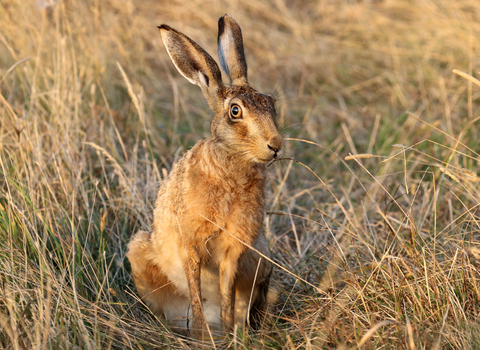
©Jim Higham

©David Tipling/2020VISION

©Chris Gomersall/2020VISION
Brown hare
The brown hare is known for its long, black-tipped ears and fast running - it can reach speeds of 45mph when evading predators.
Scientific name
Lepus europaeusWhen to see
January to DecemberSpecies information
Category
Statistics
Length: 50-70cmWeight: 2-5kg
Average lifespan: 2-4 years
Introduced, but naturalised species. Protected in the UK under the Wildlife and Countryside Act, 1981. Priority Species under the UK Post-2010 Biodiversity Framework.
About
Thought to have been introduced into the UK in Roman times (or even earlier), the brown hare is now considered naturalised. It is most common on open farmland, in grassland habitats and at woodland edges, favouring a mosaic of arable fields, grasses and hedgerows. It grazes on vegetation and the bark of young trees and bushes. Brown hares do not dig burrows, but shelter in 'forms', which are shallow depressions in the ground or grass; when disturbed, they can be seen bounding across the fields, using their powerful hind legs to propel them forwards, often in a zigzag pattern. Brown hares are at their most visible in early spring when the breeding season encourages fighting or 'boxing'. Females can produce three to four litters of two to four young (known as leverets) a year.How to identify
The brown hare is golden-brown, with a pale belly and a white tail. It is larger than the rabbit, with longer legs and longer ears with distinctive black tips.Distribution
Widespread across the UK but declining.Did you know?
If you spot brown hares 'boxing' in the fields, it is most likely that you are watching a female warding off the advances of an amorous male, not two males fighting. If a fight does happen, the two hares will stand on their hind legs and attack each other with their front paws, pulling out fur. This gives the impression of two boxers in a ring.Watch
Brown Hare (https://vimeo.com/642260697)
Russell Savory
